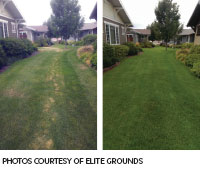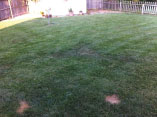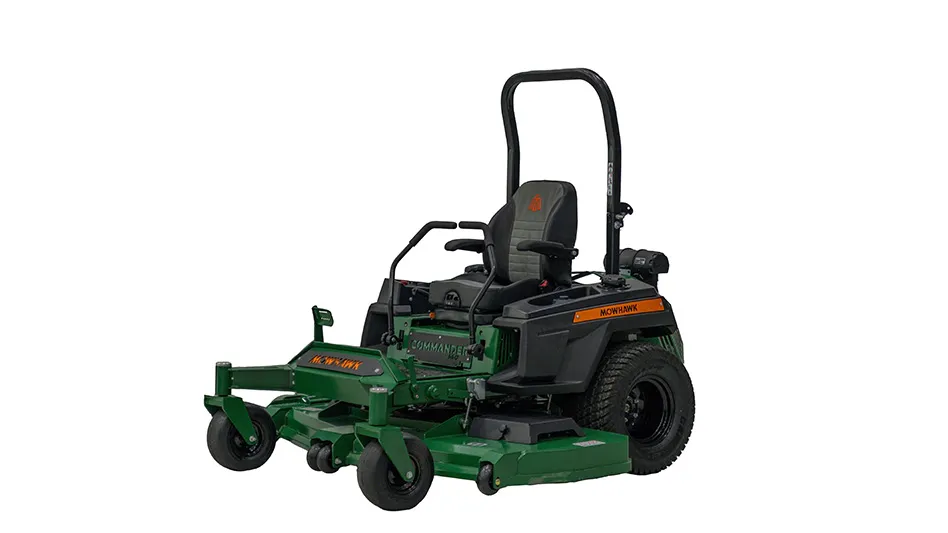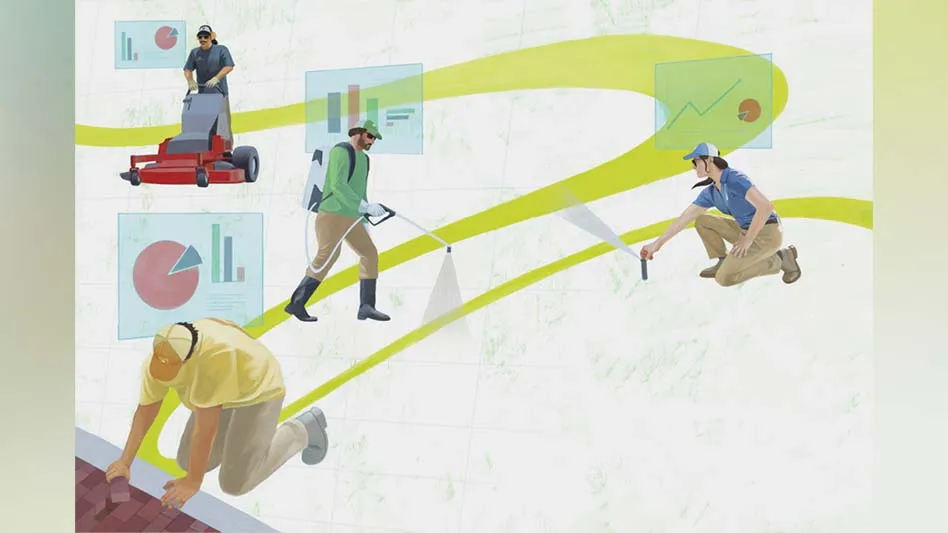 When Elite Grounds’ crew left the property, the freshly mowed lawns looked green. But three days later, the HOA president called back with a big problem – and a lot less green, because something was quickly killing the grass.
When Elite Grounds’ crew left the property, the freshly mowed lawns looked green. But three days later, the HOA president called back with a big problem – and a lot less green, because something was quickly killing the grass.
Kris Ashby, owner of the lawn and landscape company in Pleasant Grove, Utah, visited the site for a closer look. He identified brown patch fungus, which was rare in the typically cool, dry climate – until an unusually hot, humid July created the perfect environment.
“The biggest problem I see is the amount of misdiagnosing,” says Ashby, who received calls from competitors’ misdiagnosed customers, and picked up sub work from fungus-frustrated LCOs. “I walked onto several projects this summer where they didn’t even diagnose it as fungus. They diagnosed it as insect problems and put down insecticides, and that didn’t do anything.
In the day it took to diagnose and treat, the fungus grew about 25 percent, spreading over thousands of square feet. Because fungus can spread fast under prime conditions, the pressure is on LCOs to properly identify and treat damage – and proactively prevent spores.
Identification.
The first step is understanding which plants and conditions are susceptible to which fungi. Integrated Pest Management illustrates this with the disease triangle.
“It takes three things to have a disorder on a lawn: the host plant, the fungal pathogen, and the proper environment,” says Peter Estournes, who owns Gardenworks, a full-service landscape contracting company. “You could have a host and the pathogen, but if it’s not the proper environment – like hot, wet weather – you don’t have the disease.”
That’s why Estournes doesn’t see much fungi – or fungicide – in Sonoma County, Calif. But fungi-prone regions with hot, rainy climates rely on preventative treatment for control.
 Where fungi are prevalent, technicians grow familiar with the blotches, rings and color legions associated with common fungi. Still, fungi is easily mistaken. Different fungi can inflict similar symptoms (compare brown patch and dollar spot), and one fungus can look different on different plants.
Where fungi are prevalent, technicians grow familiar with the blotches, rings and color legions associated with common fungi. Still, fungi is easily mistaken. Different fungi can inflict similar symptoms (compare brown patch and dollar spot), and one fungus can look different on different plants.
Unfortunately, by the time you notice the damage, it may be too late, anyway.
“A lot of spores become active in the spring, but damage appears in the summer,” Ashby says. “You see necrotic ring when it gets hot, but you can’t treat it then because the spores are inactive. Preventatively, you have to go after certain fungi without ever seeing it, because spore activity happens at a different time than the symptoms.”
Spores are usually predictable, but changing conditions, as in Utah, invite exceptions. If you’re stumped by fungus, send photos to fungicide manufacturing companies, local universities, extension offices or even other LCOs for help.
Treatment.
While identification is crucial for effective treatment, certain treatments can cover the bases. Because fungicides work differently, some recommend multi-purpose fungicides for maximum results.
“A lot of funguses look very similar, so we use fungicides with dual modes of action,” says Joe Weiss, owner of Green Rx in Saint Charles, Mo. “If you take a targeted approach, you may not even be targeting the proper fungus due to misdiagnosis. Even if you do get the diagnosis correct, you’re still susceptible to other types of fungus. We use broad-spectrum applications to cover all potential fungus because when you have one, conditions are right for others.”
If the conditions are ripe for fungus, according to IPM’s disease triangle, perhaps the conditions should change.
“A lot of fungal diseases are treatable with a change in cultural practices,” Estournes says. “They’re brought on by the lawn staying too wet for too long. Usually it can be taken care of by drying out the lawn and cutting back on water, because most fungal diseases are waterborne.”
 So when Brown Patch popped up in Utah after abnormally humid nights, Ashby adjusted watering schedules to drip irrigation during the day. Others, like Steve Okros at Heron Pest and Lawn Control in Orlando, Fla., recommend soakers over misters to saturate roots rather than leaf blades.
So when Brown Patch popped up in Utah after abnormally humid nights, Ashby adjusted watering schedules to drip irrigation during the day. Others, like Steve Okros at Heron Pest and Lawn Control in Orlando, Fla., recommend soakers over misters to saturate roots rather than leaf blades.
Like human bodies, healthier turf is stronger against disease. Weiss’s treatments include organic applications to amend soil and strengthen roots.
He also recommends amino-acid based stress-reducing treatments for reinforcement. Ashby’s applications include bio-enhanced fertilizers to balance soil.
Besides water and fertilization, consider shade, slopes, and other conditions that contribute to fungus.
“It’s almost always a secondary issue,” Okros says. “Fungus just doesn’t say, ‘I’m going to go attack this healthy plant.’ You get fungus because the plant is weak or vulnerable because it’s buried too deep, getting too much shade, or too much water. You can throw fungicides at it, but a hawthorn that requires full sun and receives regular shade will always be dealing with fungus, even if we spray it every two weeks forever, because the conditions are favorable.”
Teaching.
Ultimately, fungus control requires educating customers to weigh treatment options and set realistic expectations. “Lawn fungicide can get confusing for customers,” says Weiss, who provides pictures and tips through Green Rx’s Facebook page, email newsletters and invoices. “It’s very weather-dependent.”
By helping customers manage environments and select resistant species, LCOs can condition lawns to resist the warm, wet temptations of fungus. Sometimes, the best treatment is not treatment at all.
“The biggest mistake with fungicide is overusing it,” Okros says. “Don’t throw fungicides at it to correct the problem without looking at what’s causing it.”
The author is a freelance writer based in Cleveland.

Explore the January 2014 Issue
Check out more from this issue and find you next story to read.





